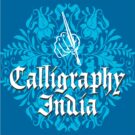Calligraphy
The word calligraphy literally means beautiful writing. The relevance of calligraphy lies in the human need for expression, through mark making, symbols, designing, drawing, painting and crafting.
Calligraphy encompasses or is influential to other relevant topics: book designing, manuscript of books, typeface designing, bookbinding, logo designing, sign making, beautiful handwriting, calligraphy as illustration and artistic expression, etc.
It is for these benefits that a learner drives from calligraphy and tests of time it has withstood that Calligraphy is still flourishing today. Those who have learnt this art, and will learn it, have always been gainers – not losers.
We recognize the fact that handwriting commenced with the coming into being of the present civilization. And it will be continued to be used till the present civilized world continues to exist. Therefore, calligraphy as an art will also remain in great demand, as it is today and in future too.
Calligraphy covers a huge area of study. No one can start to learn everything at once. But you must make a start.
This start, when followed with perseverance, will take you to your cherished goal – your goal to learn calligraphy to your satisfaction.
What is Calligraphy?
Calligraphy is more than ‘beautiful handwriting’ or ‘ornate lettering techniques.’
Calligraphy is the art of forming beautiful symbols by hand and arranging them well.
It’s a set of skills and techniques for positioning and inscribing words so they show integrity, harmony, some sort of ancestry, rhythm and creative fire.
Useful notes:
Symbol here means a mark which has a specific agreed-upon meaning in a language, like a letter of the alphabet, a numeral or a word.
Integrity of a letter or other symbol means admirable proportions and form.
Harmony describes a pleasing relationship between different visual elements in a piece of calligraphy: parts of a letter, letters, words, the whole text and surrounding space.
Ancestry refers to the heritage of letter-shapes, materials and techniques which calligraphers use.
Rhythm means the calligrapher’s deliberate repetition and variation of marks and spaces to create feelings of pattern and emphasis when you look at the work.
Creative fire … well … that’s the slightly mysterious life and individuality of any piece of art. That’s the part of it which is you.
Myth busting: what is calligraphy not?
1.”What is calligraphy?” — “Ornamental decorated letters.”
Nope. Calligraphy is not just about decorated text, nor is it only about the use of letters as ornaments. It’s more than that.
Calligraphy is about symbols themselves being beautifully formed and arranged.
There is a big difference between a beautiful form and beautiful ornament on top of a form.
Think of the structure and form of an alphabet-letter, or even a whole page of text, as being like the bones and muscles of a body. Naked, undecorated calligraphy should look good just as it is, in the same way that athletes, models and healthy people would look good without their clothes on.
2.”What is calligraphy?” — “Beautiful handwriting.” Not exactly and not entirely. Calligraphy means more than just beautiful handwriting.
True, the Greek derivation of ‘calligraphy’ translates simply as ‘beautiful writing’. But the word has taken on a larger meaning.
What is the difference between Calligraphy & Handwriting ?
Calligraphy aims to produce an ‘art’ reaction, in which a deeper meaning is communicated from artist to viewer, and the viewer feels invited to think a new thought in response.
Handwriting, by contrast, aims to be read. The first goals of handwriting are to be quickly and easily written and accurately read. Beauty, personality and artistic impact are not as important in handwriting as clarity and speed.
3.”What is calligraphy?” — “It’s lettering that’s done by hand.” Well, no. Calligraphy is not exactly the same as lettering.’
Yes, calligraphy requires good letter-formation, and so calligraphy is a form or mode of lettering by hand. But ‘lettering’ and ‘calligraphy’ are still different disciplines.
There is a big overlap between calligraphy and lettering. But their purposes aren’t the same
4.”What is calligraphy?” — “Just really old-style writing.” No, no, no. Calligraphy is not mere reproduction of historical alphabets.
Only copying the handwriting-style or the work of others in the past is not the creative purpose of calligraphy.
Learning how to write historical hands is an excellent method of training the hand and eye, but it’s not the calligrapher’s final destination.
5.”What is calligraphy?” — “Oh, any kind of fancy font.” No, again! Calligraphy is not a font or a typeface.
Fonts are the styles of lettering used in machines and printing-presses.
the individual ‘stamp’ of the calligrapher’s personality on the work is ultimately what makes calligraphy an art form. The individual ‘fire’ or ‘soul’ which is unique to one piece doesn’t translate into letter-forms that have been standardised for machine use.
Calligraphy is a skill. This skill involves touch, pressure, hand movement, unity, and that elusive quality we term “beauty.” (V. Studley, Left-Handed Calligraphy (NY: Dover, 1991), p. 8)
… Calligraphy is a script that exhibits exceptional and often self-conscious artistry and aesthetic quality in design and execution. (M. P. Brown, Understanding Illuminated Manuscripts: A Guide to Technical Terms (London: The British Library, 1994), p. 32
In short:
Calligraphy is writing as art: it is making meaningful marks beautifully so they show INTEGRITY, HARMONY, ANCESTRY, RHYTHM and SOUL.
(Excerpt from http://www.calligraphy-skills.com/what-is-calligraphy.html)
